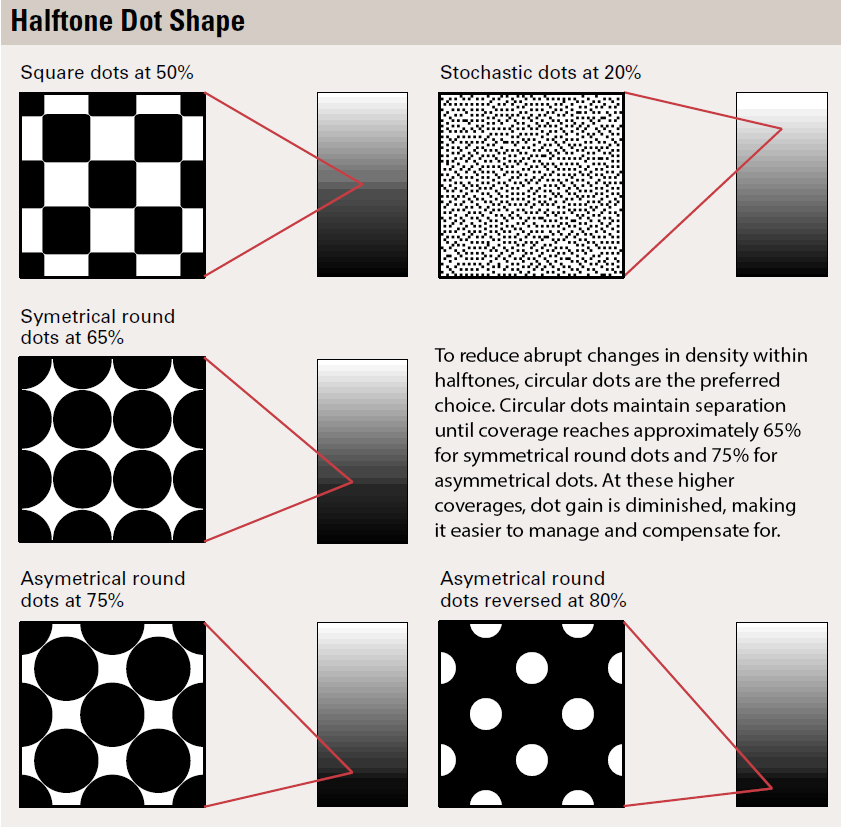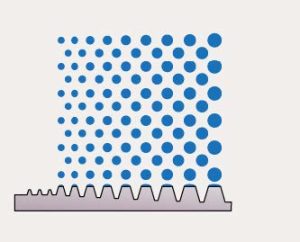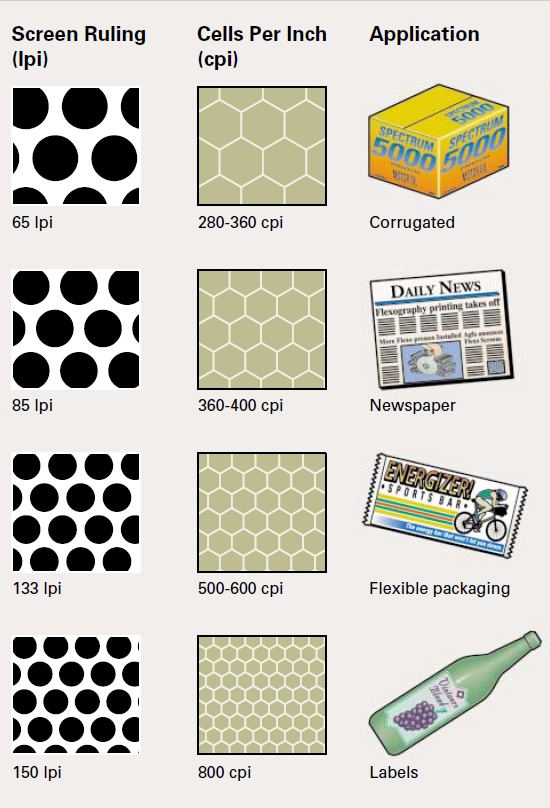Halftones and Screening in Flexography
- Khobre Mihan co
- Article
- Halftones and Screening in Flexography
Over time, flexography has been used to produce excellent line art and spot colors on a diverse range of materials. However, its recent enhancements in providing high-quality and cost-effective four-color process printing have positioned flexography as a superior choice for packaging applications compared to other printing methods.
The Shape of the Halftone Dot
In flexography, the form of the halftone dot used for recreating a continuous tone image can significantly impact the image’s density. Halftone dots come in various shapes, such as square, elliptical, octagonal, and both symmetrical and asymmetrical shapes. For instance, at 50% coverage, square dots create a pattern resembling a checkerboard, with individual dots just starting to connect at their corners. However, when plates are produced from film, dot gain leads to increased dot connection, resulting in abrupt changes in density on the printed image instead of a smooth, uninterrupted transition.
To reduce abrupt changes in density, printers can employ different types of dots that maintain their distinct shape even at coverages of sixty and seventy percent. For instance, round or octagonal dots are commonly utilized for this purpose. While most design software can indicate round dots, it’s important to decide on the dot shape early in the process to avoid selecting a shape that might not be supported by the RIP, imagesetter, or plate setter.
Conventional Screen Ruling
Choosing the correct screen ruling is crucial for four-color process flexography and is often determined by the type of substrate being used. Anilox cell count and screen ruling for separations should be matched for optimal outcomes. The cells of the anilox, which transfer ink to a halftone plate, should be sufficiently large to produce the right color intensity but not so large that the halftone dots sink into them like an inkwell. For traditional halftones, resolution is described as the number of lines of halftone dots per inch, also known as screen ruling or lines per inch (lpi). Higher screen rulings create higher resolution images because there are more dots per square inch used to capture detail. For example, compare the images in a newspaper (low screen ruling) to a picture in a monthly magazine (high screen ruling) to observe the difference in quality.
Stochastic Screening
Stochastic Screening, also known as Frequency Modulated (FM) screening, presents several advantages compared to traditional halftone screening. It eliminates the risk of moiré patterns and allows flexographic printers to employ HiFi color, involving the use of six or seven process colors.
However, it’s important to note that the dot size used in stochastic screening is exceptionally small, similar in size to the highlight dot in conventional screening. Given that flexography experiences significant dot gain, the application of stochastic screening should be undertaken only after the printer and color separator have conducted press fingerprints. This process is necessary to determine the optimal dot size and ensure accurate compensation for dot gain.
To reduce abrupt changes in density within halftones, circular dots are the preferred choice. Circular dots maintain separation until coverage reaches approximately 65% for symmetrical round dots and 75% for asymmetrical dots. At these higher coverages, dot gain is diminished, making it easier to manage and compensate for.

Highlights
The majority of photopolymer plates have the capacity to retain a 2% highlight dot. However, inadequate exposure of plates can result in the dropout of screen tints and highlight dots measuring less than 3%. Due to the susceptibility of small dots in highlight areas to significant dot gain, it’s crucial to engage in discussions with the printer about any highlight limitations before creating separations. While offset lithography printers can achieve acceptable highlights with 5% film dots, flexographic printers might need to reduce an equally bright highlight to 2%, considering the impact of dot gain.

Gradations and Vignettes
The dot gain experienced in flexography highlights poses challenges in achieving a smooth fade-to-white gradient without a noticeable abrupt transition at the highlight edge. When creating images for flexography, it is advisable to allow the design to fade off naturally at the end rather than fading directly to white. Alternatively, placing a border at the highlight end of a vignette can also be an effective strategy.

Line Screens and Cells Per Inch
The corrugated industry utilizes halftones screened at 45, 55, 65, or 85 lines per inch (lpi).
Newspaper printers that employ flexography print halftones screened in the range of 65 to 100 lines per inch (lpi).
Halftone printing on flexible packaging with film substrates is frequently conducted within the range of 120 to 150 lines per inch (lpi).
Sophisticated label printers with high-quality capabilities are capable of producing images with a resolution of 200 lines per inch (lpi).

Anilox Cell Angles and Halftone Screen Angles
Cells are etched onto an anilox roll at one of three angles: 30°, 45°, or 60°.

The plate’s line count should not exceed 25% of the anilox’s cells per inch. Ideally, there should be a minimum of four cells on the anilox for each halftone dot.

To prevent anilox moiré, it is recommended to set film or plate screen angles at a minimum of 7.5° away from the anilox cell angle. Additionally, screen angles for cyan, magenta, yellow, and black should be positioned at least 15° apart from each other.

We help our customers stand out in the market by providing superior packaging solutions
To achieve this goal, we continuously invest in developing our relationships with our customers so that we can meet the needs of our customers today and tomorrow. The consulting and design team of Mehen’s expert engineers, after hearing the demands of the customers, examined the different ways of packaging the product and then using the valuable experiences of the past and the current knowledge of packaging and the use of new technologies, the most optimal type of packaging examined. provides to consumers. For more information and consultation with us, click on the free consultation button.

